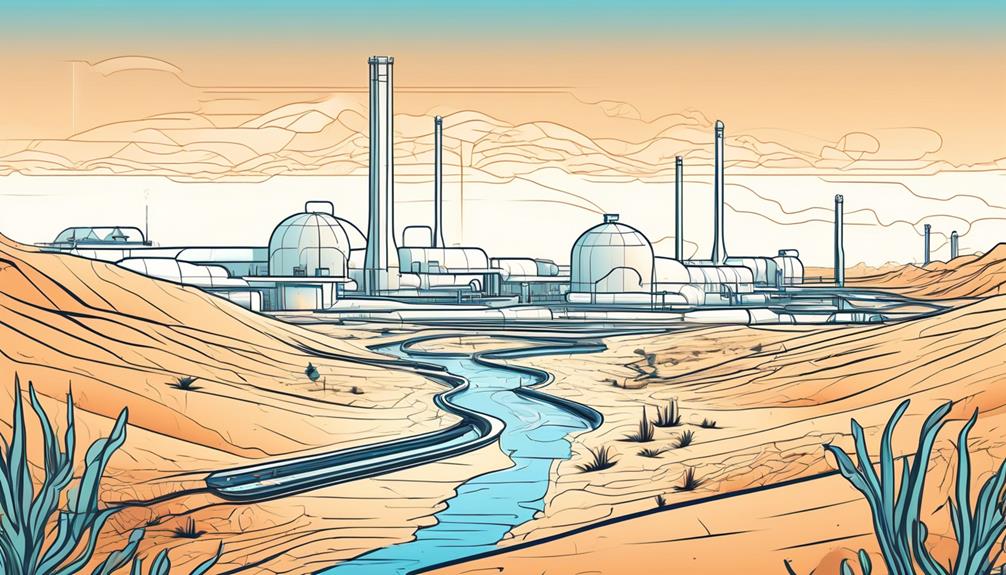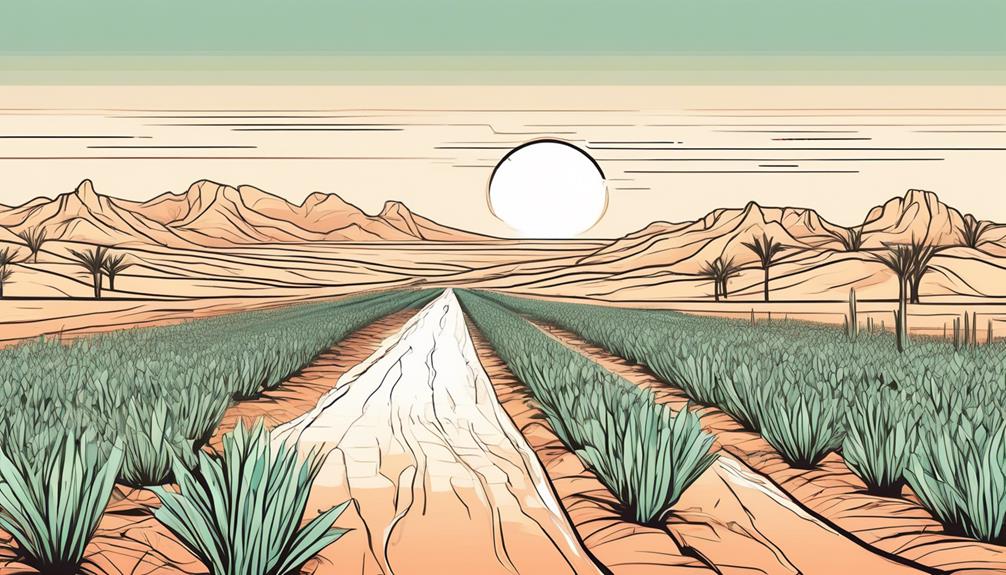Imagine a lone cactus in the vast desert, surviving with minimal water by storing it efficiently within its structure. Just like this resilient plant, desert regions facing water scarcity require innovative solutions to thrive.
From implementing drip irrigation systems that mimic nature's slow but steady approach to embracing rainwater harvesting techniques that capitalize on every drop, the strategies available are diverse and promising.
As you ponder the challenges these arid areas face, consider the transformative power of solutions like desalination plants and community wells, each offering a beacon of hope in a parched landscape.
Key Takeaways
- Implementing drip irrigation systems and water-efficient crop cultivation techniques can significantly reduce water usage in desert regions.
- Utilizing rainwater harvesting techniques can help supplement water sources in areas with limited water availability.
- Embracing desalination solutions such as desalination plants and technologies can provide a reliable source of freshwater in arid regions.
- Community water management strategies like community wells and equitable water distribution programs are essential for addressing water scarcity in desert regions.
Drip Irrigation Systems
To combat water scarcity in deserts, implementing drip irrigation systems can efficiently deliver water directly to plant roots, saving resources and promoting sustainable agriculture. Picture this: instead of water evaporating under the scorching sun or being wasted on barren land, drip irrigation systems release water slowly and precisely at the base of each plant. It's like giving each plant its own personal water supply, ensuring that every drop counts.
This targeted approach not only conserves water by minimizing evaporation but also reduces weed growth since only the plants receive water, depriving weeds of the moisture they need to thrive. By using drip irrigation, you optimize water usage, lower your water bills, and nurture healthier plants. Imagine transforming a dry, dusty desert into a thriving oasis of greenery, all thanks to the smart and efficient technology of drip irrigation systems.
Rainwater Harvesting Techniques
Let's talk about three effective rainwater harvesting techniques to tackle desert water scarcity:
Firstly, the rooftop collection system captures rain from your roof, directing it into storage containers.
Secondly, groundwater recharge methods involve allowing rainwater to seep into the ground, replenishing underground water sources.
Lastly, utilizing cistern storage solutions to store rainwater for later use is a practical option for managing water scarcity in arid regions.
Rooftop Collection System
With a rooftop collection system, rainwater harvesting becomes an essential practice to combat desert water scarcity.
Here are three reasons why rooftop collection systems are a game-changer in solving water scarcity in desert regions:
- Efficient Water Utilization: Every drop of rainwater that lands on your roof can be collected and stored for future use, reducing reliance on scarce water sources.
- Cost-Effective Solution: Installing a rooftop collection system is a one-time investment that can significantly lower water bills in the long run.
- Environmentally Friendly: By harvesting rainwater, you're contributing to water conservation efforts and reducing the strain on existing water supplies.
Groundwater Recharge Methods
Recharging groundwater through innovative rainwater harvesting techniques provides a sustainable solution to replenish depleted aquifers in desert regions. By capturing rainwater from rooftops and directing it to underground storage tanks or recharge pits, you can replenish groundwater levels. These methods prevent water runoff and allow the water to seep into the ground, replenishing aquifers over time.
Additionally, constructing swales or trenches to capture and redirect rainwater can help recharge groundwater naturally. Implementing permeable pavements in urban areas also aids in groundwater recharge by allowing rainwater to infiltrate the soil. These techniques not only help combat water scarcity but also contribute to the long-term sustainability of water resources in desert regions.
Cistern Storage Solutions
To further enhance groundwater replenishment in desert areas, consider implementing cistern storage solutions as part of your rainwater harvesting techniques.
- Underground Cisterns: Install underground cisterns to collect and store rainwater, keeping it cool and reducing evaporation.
- Above-Ground Cisterns: Utilize above-ground cisterns for easier access and maintenance, allowing for visible water levels and simple monitoring.
- Modular Cistern Systems: Opt for modular cistern systems that can be easily expanded or reconfigured based on water needs, providing flexibility and scalability.
Water Recycling Technologies
Water Recycling Technologies play a vital role in addressing desert water scarcity by efficiently reusing and treating water resources. These technologies encompass various methods to recycle wastewater and make it safe for reuse.
One common technique is greywater recycling, which involves treating water from sinks and showers for non-potable uses like irrigation and flushing toilets. Another innovative approach is blackwater recycling, which treats water from toilets to a level where it can be reused safely.
Moreover, advanced purification technologies such as reverse osmosis and ultraviolet disinfection are instrumental in recycling water for drinking purposes. These systems remove impurities and contaminants, ensuring that the recycled water meets safety standards. Additionally, the integration of smart monitoring systems allows for real-time tracking of water quality, ensuring the effectiveness of the recycling process.
Desalination Plants

Desalination plants are crucial for transforming seawater into freshwater in arid regions facing water scarcity. Here are three key points that make desalination plants a vital solution in combating water shortages:
- Advanced Technology: Desalination plants utilize state-of-the-art technology like reverse osmosis to remove salt and impurities from seawater, producing clean drinking water.
- Reliable Water Supply: These plants offer a reliable source of freshwater independent of rainfall, making them particularly valuable in arid regions where traditional water sources are scarce.
- Environmental Impact: While energy-intensive, desalination plants are becoming more sustainable through innovations like renewable energy integration and improved efficiency, reducing their environmental footprint.
Community Wells and Water Banks
Hey there!
Let's chat about keeping those community wells in tip-top shape and setting up water sharing programs.
Imagine a network of wells supported by smart maintenance plans, ensuring reliable water access.
Picture communities coming together to share this precious resource, creating a sustainable water bank for everyone to benefit from.
Well Maintenance Strategies
To ensure the longevity and efficiency of community wells and water banks, regular maintenance is crucial for sustainable water access in arid regions. Here are three essential strategies to keep these vital water sources functioning optimally:
- Scheduled Inspections: Regularly check well components for wear and tear to prevent breakdowns.
- Proactive Cleaning: Keep wells free from debris and sediment buildup to maintain water quality and flow.
- Prompt Repairs: Address any issues promptly to prevent minor problems from escalating into costly repairs.
Water Sharing Programs
Water Sharing Programs such as community wells and water banks play a vital role in ensuring sustainable access to water in arid regions. By coming together as a community to manage and distribute water resources efficiently, everyone benefits from increased water security. Here is a breakdown of how these programs can help:
| Benefits of Water Sharing Programs |
|---|
| 1. Equitable water distribution among community members. |
| 2. Reduces individual water extraction pressure on local sources. |
| 3. Promotes cooperation and unity within the community. |
| 4. Ensures water availability even during droughts. |
Through these programs, communities can overcome water scarcity challenges collectively, ensuring a more secure water future for all.
Water-Efficient Crop Cultivation

Amidst the challenges of desert water scarcity, adopting innovative techniques for cultivating crops with minimal water usage is crucial for sustainable agriculture. To tackle this issue effectively, consider the following strategies:
- Drip Irrigation Systems: Implementing drip irrigation systems delivers water directly to the roots of plants, reducing evaporation and water waste significantly.
- Xeriscaping: Utilize xeriscaping methods by selecting drought-resistant crop varieties and arranging plants strategically to maximize water efficiency.
- Mulching: Apply mulch around crops to retain soil moisture, suppress weed growth, and regulate soil temperature, thereby conserving water effectively.
Education and Awareness Programs
Considering the pressing need for informed action, engaging educational programs can empower communities to address desert water scarcity effectively. By providing knowledge about water conservation techniques, sustainable water usage, and the importance of preserving water sources, these programs play a crucial role in changing behaviors and attitudes towards water management in arid regions.
| Benefits of Education and Awareness Programs |
|---|
| 1. Increased Awareness |
| 2. Behavior Change |
| 3. Sustainable Practices |
| 4. Community Empowerment |
| 5. Long-Term Solutions |
Increased awareness through workshops, seminars, and community events helps individuals understand the impact of their water consumption habits. This knowledge can lead to significant behavior changes, such as reducing water wastage and adopting more sustainable practices. By empowering communities with the necessary information and skills, education programs pave the way for long-term solutions to desert water scarcity.
Frequently Asked Questions
How Do Desert Regions Manage to Sustain Agriculture With Limited Water Resources?
To sustain agriculture in deserts with limited water, you need innovative techniques like drip irrigation, mulching, and water-efficient crops. By carefully managing resources and utilizing technology, desert regions can grow crops efficiently despite the scarcity of water.
What Are the Potential Environmental Impacts of Implementing Desalination Plants in Desert Regions?
When you consider the potential environmental impacts of building desalination plants in desert regions, think about the energy consumption, marine life disruption, and brine disposal. It's crucial to weigh these factors for sustainable solutions.
Are There Any Government Subsidies or Incentives Available to Encourage the Adoption of Water-Efficient Crop Cultivation Techniques in Desert Regions?
You can save money and help the environment by adopting water-efficient crop techniques in desert regions. Government subsidies and incentives are available to support your efforts. Start making a positive impact today!
How Do Community Wells and Water Banks Function in Terms of Managing Water Distribution in Desert Regions?
In desert regions, community wells act as shared sources of water for residents. Water banks store excess water for dry spells. They help manage distribution efficiently, ensuring everyone has access to this vital resource.
What Are Some Innovative Technologies Being Developed to Address Water Scarcity in Desert Regions Beyond the Solutions Mentioned in the Article?
Delve deeper into desert water woes. Explore emerging technologies like fog catchers, solar desalination, and hydropanels. These cutting-edge solutions promise to provide sustainable water sources, tackling scarcity with innovation and ingenuity.
Conclusion
In conclusion, implementing solutions like drip irrigation systems, rainwater harvesting, and desalination plants can help combat water scarcity in desert regions.
Did you know that according to the UN, by 2025, two-thirds of the world could be living in water-stressed conditions, making it crucial to take action now?
By utilizing these innovative technologies and practices, we can ensure a sustainable water supply for future generations in arid areas.
Let's work together to make a difference!